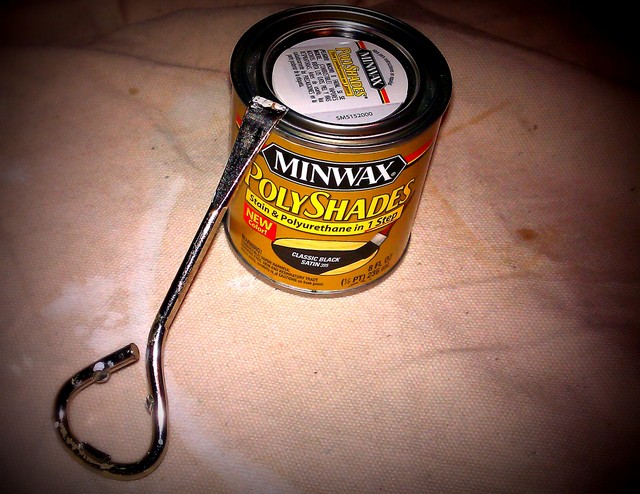Further to the last post on my implementation of a strongly-typed variant of WeakReferemce, I thought it would be apropos to post another utility class surrounding weak references. This one really is more academic than useful considering that one could just stick WeakReference<T> into a regular Dictionary<TKey, TValue> and get almost the same functionality. All this class really does is hide away how we're managing the reference inside the dictionary.
/// <summary>
/// Represents a dictionary that only holds weak references on values stored within it.
/// </summary>
/// <typeparam name="TKey">The type of the key.</typeparam>
/// <typeparam name="TValue">The type of the value.
/// <remarks>This must be a reference type (by definition, there's no reason to have a weak reference on value types).</remarks>
/// </typeparam>
public class WeakReferenceDictionary<TKey, TValue> : IDictionary<TKey, TValue> where TValue : class
{
private readonly Dictionary<TKey, WeakReference<TValue>> realDictionary;
/// <summary>
/// Initializes a new instance of the <see cref="WeakReferenceDictionary"/>
/// class that is empty, has the default initial capacity, and uses the default
/// equality comparer for the key type.
/// </summary>
public WeakReferenceDictionary()
{
this.realDictionary = new Dictionary<TKey, WeakReference<TValue>>();
}
/// <summary>
/// Initializes a new instance of the <see cref="WeakReferenceDictionary"/>
/// class that is empty, has the specified initial capacity, and uses the default
/// equality comparer for the key type.
/// </summary>
/// <param name="capacity">
/// The initial number of elements that the <see cref="WeakReferenceDictionar"/>
/// can contain.
/// </param>
/// <exception cref="System.ArgumentOutOfRangeException">
/// <paramref name="capacity"/> is less than <c>0</c>.
/// </exception>
public WeakReferenceDictionary(int capacity)
{
this.realDictionary = new Dictionary<TKey, WeakReference<TValue>>(capacity);
}
/// <summary>
/// Initializes a new instance of the <see cref="WeakReferenceDictionary"/>
/// class that is empty, has the default initial capacity, and uses the specified
/// <see cref="System.Collections.Generic.IEqualityComparer" />.
/// </summary>
/// <param name="comparer">
/// The <see cref="System.Collections.Generic.IEqualityComparer" /> implementation to use
/// when comparing keys, or <c>null</c> to use the default <see cref="System.Collections.Generic.EqualityComparer" />
/// for the type of the key.
/// </param>
public WeakReferenceDictionary(IEqualityComparer<TKey> comparer)
{
this.realDictionary = new Dictionary<TKey, WeakReference<TValue>>(comparer);
}
/// <summary>
/// Initializes a new instance of the <see cref="WeakReferenceDictionary" />
/// class that is empty, has the specified initial capacity, and uses the specified
/// <see cref="System.Collections.Generic.IEqualityComparer" />.
/// <param name="capacity">
/// The initial number of elements that the <see cref="WeakReferenceDictionary" />
/// can contain.
/// </param>
/// <param name="comparer">
/// The <see cref="System.Collections.Generic.IEqualityComparer<T>" /> implementation to use
/// when comparing keys, or <c>null</c> to use the default <see cref="System.Collections.Generic.EqualityComparer<T>" />
/// for the type of the key.
/// </param>
/// <exception cref="System.ArgumentOutOfRangeException">
/// <paramref name="capacity"/> is less than <c>0</c>.
/// </exception>
public WeakReferenceDictionary(int capacity, IEqualityComparer<TKey> comparer)
{
this.realDictionary = new Dictionary<TKey, WeakReference<TValue>>(capacity, comparer);
}
/// <summary>
/// Initializes a new instance of the <see cref="WeakReferenceDictionary<TKey, TValue>"/>
/// class that contains elements copied from the specified <see cref="System.Collections.Generic.IDictionary<TKey,TValue>" />
/// and uses the default equality comparer for the key type.
/// </summary>
/// <param name="dictionary">The <see cref="System.Collections.Generic.IDictionary<TKey,TValue>" /> whose elements are
/// copied to the new <see cref="WeakReferenceDictionary<TKey, TValue>"/>.
/// </param>
/// <exception cref="T:System.ArgumentNullException">
/// <paramref name="dictionary"/> is <c>null</c>.
/// </exception>
/// <exception cref="T:System.ArgumentException">
/// <paramref name="dictionary"/> contains one or more duplicate keys.
/// </exception>
public WeakReferenceDictionary(IDictionary<TKey, TValue> dictionary)
{
this.realDictionary = new Dictionary<TKey, WeakReference<TValue>>(
dictionary.ToDictionary(pair => pair.Key, pair => new WeakReference<TValue>(pair.Value)));
}
/// <summary>
/// Initializes a new instance of the <see cref="WeakReferenceDictionary<TKey, TValue>"/>
/// class that contains elements copied from the specified <see cref="System.Collections.Generic.IDictionary<TKey,TValue>" />
/// and uses the specified <see cref="System.Collections.Generic.IEqualityComparer<T>" />.
/// </summary>
/// <param name="comparer">
/// The <see cref="System.Collections.Generic.IDictionary<TKey,TValue>" /> whose elements are
/// copied to the new <see cref="WeakReferenceDictionary<TKey, TValue>"/>.
/// </param>
/// <param name="dictionary">
/// The <see cref="System.Collections.Generic.IEqualityComparer<T>" /> implementation to use
/// when comparing keys, or <c>null</c> to use the default <see cref="System.Collections.Generic.EqualityComparer<T>" />
/// for the type of the key.
/// </param>
/// <exception cref="System.ArgumentNullException">
/// <paramref name="dictionary"/> is <c>null</c>.
/// </exception>
/// <exception cref="System.ArgumentException">
/// <paramref name="dictionary"/> contains one or more duplicate keys.
/// </exception>
public WeakReferenceDictionary(IDictionary<TKey, TValue> dictionary, IEqualityComparer<TKey> comparer)
{
this.realDictionary = new Dictionary<TKey, WeakReference<TValue>>(
dictionary.ToDictionary(pair => pair.Key, pair => new WeakReference<TValue>(pair.Value)),
comparer);
}
#region IDictionary<TKey,TValue> Members
/// <summary>
/// Adds an element with the provided key and value to the <see cref="T:System.Collections.Generic.IDictionary`2"/>.
/// </summary>
/// <param name="key">The object to use as the key of the element to add.</param>
/// <param name="value">The object to use as the value of the element to add.</param>
/// <exception cref="T:System.ArgumentNullException">
/// <paramref name="key"/> is null.
/// </exception>
/// <exception cref="T:System.ArgumentException">
/// An element with the same key already exists in the <see cref="T:System.Collections.Generic.IDictionary`2"/>.
/// </exception>
/// <exception cref="T:System.NotSupportedException">
/// The <see cref="T:System.Collections.Generic.IDictionary`2"/> is read-only.
/// </exception>
public void Add(TKey key, TValue value)
{
this.realDictionary.Add(key, new WeakReference<TValue>(value));
}
/// <summary>
/// Determines whether the <see cref="T:System.Collections.Generic.IDictionary`2"/> contains an element with the specified key.
/// </summary>
/// <param name="key">The key to locate in the <see cref="T:System.Collections.Generic.IDictionary`2"/>.</param>
/// <returns>
/// true if the <see cref="T:System.Collections.Generic.IDictionary`2"/> contains an element with the key; otherwise, false.
/// </returns>
/// <exception cref="T:System.ArgumentNullException">
/// <paramref name="key"/> is null.
/// </exception>
public bool ContainsKey(TKey key)
{
return this.realDictionary.ContainsKey(key);
}
/// <summary>
/// Gets an <see cref="T:System.Collections.Generic.ICollection`1"/> containing the keys of the <see cref="T:System.Collections.Generic.IDictionary`2"/>.
/// </summary>
/// <value></value>
/// <returns>
/// An <see cref="T:System.Collections.Generic.ICollection`1"/> containing the keys of the object that implements <see cref="T:System.Collections.Generic.IDictionary`2"/>.
/// </returns>
public ICollection<TKey> Keys
{
get
{
return this.realDictionary.Keys;
}
}
/// <summary>
/// Removes the element with the specified key from the <see cref="T:System.Collections.Generic.IDictionary`2"/>.
/// </summary>
/// <param name="key">The key of the element to remove.</param>
/// <returns>
/// true if the element is successfully removed; otherwise, false. This method also returns false if <paramref name="key"/> was not found in the original <see cref="T:System.Collections.Generic.IDictionary`2"/>.
/// </returns>
/// <exception cref="T:System.ArgumentNullException">
/// <paramref name="key"/> is null.
/// </exception>
/// <exception cref="T:System.NotSupportedException">
/// The <see cref="T:System.Collections.Generic.IDictionary`2"/> is read-only.
/// </exception>
public bool Remove(TKey key)
{
return this.realDictionary.Remove(key);
}
/// <summary>
/// Gets the value associated with the specified key.
/// </summary>
/// <param name="key">The key whose value to get.</param>
/// <param name="value">When this method returns, the value associated with the specified key, if the key is found; otherwise, the default value for the type of the <paramref name="value"/> parameter. This parameter is passed uninitialized.</param>
/// <returns>
/// true if the object that implements <see cref="T:System.Collections.Generic.IDictionary`2"/> contains an element with the specified key; otherwise, false.
/// </returns>
/// <exception cref="T:System.ArgumentNullException">
/// <paramref name="key"/> is null.
/// </exception>
public bool TryGetValue(TKey key, out TValue value)
{
WeakReference<TValue> reference;
if (this.realDictionary.TryGetValue(key, out reference))
{
value = reference.Target;
return true;
}
else
{
value = default(TValue);
return false;
}
}
/// <summary>
/// Gets an <see cref="T:System.Collections.Generic.ICollection`1"/> containing the values in the <see cref="T:System.Collections.Generic.IDictionary`2"/>.
/// </summary>
/// <value></value>
/// <returns>
/// An <see cref="T:System.Collections.Generic.ICollection`1"/> containing the values in the object that implements <see cref="T:System.Collections.Generic.IDictionary`2"/>.
/// </returns>
public ICollection<TValue> Values
{
get
{
return this.realDictionary
.Values
.Select(value => value.Target)
.ToList()
.AsReadOnly();
}
}
/// <summary>
/// Gets or sets the value associated with the specified key.
/// </summary>
/// <param name="key">The key of the value to get or set.</param>
/// <returns>The value associated with the specified key. If the specified key is not
/// found, a get operation throws a <see cref="System.Collections.Generic.KeyNotFoundException"/>,
/// and a set operation creates a new element with the specified key.</returns>
/// <exception cref="System.ArgumentNullException">
/// <paramref name="key"/> is <c>null</c>.
/// </exception>
/// <exception cref="System.Collections.Generic.KeyNotFoundException">
/// The property is retrieved and the key does not exist in the collection.
/// </exception>
public TValue this[TKey key]
{
get
{
return this.realDictionary[key].Target;
}
set
{
this.realDictionary[key] = new WeakReference<TValue>(value);
}
}
#endregion
#region ICollection<KeyValuePair<TKey,TValue>> Members
/// <summary>
/// Adds an item to the <see cref="T:System.Collections.Generic.ICollection`1"/>.
/// </summary>
/// <param name="item">The object to add to the <see cref="T:System.Collections.Generic.ICollection`1"/>.</param>
/// <exception cref="T:System.NotSupportedException">
/// The <see cref="T:System.Collections.Generic.ICollection`1"/> is read-only.
/// </exception>
void ICollection<KeyValuePair<TKey, TValue>>.Add(KeyValuePair<TKey, TValue> item)
{
Add(item.Key, item.Value);
}
/// <summary>
/// Removes all items from the <see cref="T:System.Collections.Generic.ICollection`1"/>.
/// </summary>
/// <exception cref="T:System.NotSupportedException">
/// The <see cref="T:System.Collections.Generic.ICollection`1"/> is read-only.
/// </exception>
public void Clear()
{
this.realDictionary.Clear();
}
/// <summary>
/// Determines whether the <see cref="T:System.Collections.Generic.ICollection`1"/> contains a specific value.
/// </summary>
/// <param name="item">The object to locate in the <see cref="T:System.Collections.Generic.ICollection`1"/>.</param>
/// <returns>
/// true if <paramref name="item"/> is found in the <see cref="T:System.Collections.Generic.ICollection`1"/>; otherwise, false.
/// </returns>
bool ICollection<KeyValuePair<TKey, TValue>>.Contains(KeyValuePair<TKey, TValue> item)
{
return this.realDictionary.ContainsKey(item.Key);
}
/// <summary>
/// Copies the elements of the <see cref="T:System.Collections.Generic.ICollection`1"/> to an <see cref="T:System.Array"/>, starting at a particular <see cref="T:System.Array"/> index.
/// </summary>
/// <param name="array">The one-dimensional <see cref="T:System.Array"/> that is the destination of the elements copied from <see cref="T:System.Collections.Generic.ICollection`1"/>. The <see cref="T:System.Array"/> must have zero-based indexing.</param>
/// <param name="arrayIndex">The zero-based index in <paramref name="array"/> at which copying begins.</param>
/// <exception cref="T:System.ArgumentNullException">
/// <paramref name="array"/> is null.
/// </exception>
/// <exception cref="T:System.ArgumentOutOfRangeException">
/// <paramref name="arrayIndex"/> is less than 0.
/// </exception>
/// <exception cref="T:System.ArgumentException">
/// <paramref name="array"/> is multidimensional.
/// -or-
/// <paramref name="arrayIndex"/> is equal to or greater than the length of <paramref name="array"/>.
/// -or-
/// The number of elements in the source <see cref="T:System.Collections.Generic.ICollection`1"/> is greater than the available space from <paramref name="arrayIndex"/> to the end of the destination <paramref name="array"/>.
/// -or-
/// Type <paramref name="T"/> cannot be cast automatically to the type of the destination <paramref name="array"/>.
/// </exception>
void ICollection<KeyValuePair<TKey, TValue>>.CopyTo(KeyValuePair<TKey, TValue>[] array, int arrayIndex)
{
if (array == null)
{
throw new ArgumentNullException("array", "Array cannot be null");
}
if ( (arrayIndex < 0) || (arrayIndex > array.Length) )
{
throw new ArgumentOutOfRangeException("array", "Index must be a non-negative value within the array");
}
if ((array.Length - arrayIndex) < this.realDictionary.Count)
{
throw new ArgumentException("Array is too small", "array");
}
foreach (var pair in this.realDictionary)
{
array[arrayIndex++] = new KeyValuePair<TKey, TValue>(pair.Key, pair.Value.Target);
}
}
/// <summary>
/// Gets the number of elements contained in the <see cref="T:System.Collections.Generic.ICollection`1"/>.
/// </summary>
/// <value></value>
/// <returns>
/// The number of elements contained in the <see cref="T:System.Collections.Generic.ICollection`1"/>.
/// </returns>
public int Count
{
get
{
return this.realDictionary.Count;
}
}
/// <summary>
/// Gets a value indicating whether the <see cref="T:System.Collections.Generic.ICollection`1"/> is read-only.
/// </summary>
/// <value></value>
/// <returns>true if the <see cref="T:System.Collections.Generic.ICollection`1"/> is read-only; otherwise, false.
/// </returns>
public bool IsReadOnly
{
get
{
return false;
}
}
/// <summary>
/// Removes the first occurrence of a specific object from the <see cref="T:System.Collections.Generic.ICollection`1"/>.
/// </summary>
/// <param name="item">The object to remove from the <see cref="T:System.Collections.Generic.ICollection`1"/>.</param>
/// <returns>
/// true if <paramref name="item"/> was successfully removed from the <see cref="T:System.Collections.Generic.ICollection`1"/>; otherwise, false. This method also returns false if <paramref name="item"/> is not found in the original <see cref="T:System.Collections.Generic.ICollection`1"/>.
/// </returns>
/// <exception cref="T:System.NotSupportedException">
/// The <see cref="T:System.Collections.Generic.ICollection`1"/> is read-only.
/// </exception>
bool ICollection<KeyValuePair<TKey, TValue>>.Remove(KeyValuePair<TKey, TValue> item)
{
return Remove(item.Key);
}
#endregion
#region IEnumerable<KeyValuePair<TKey,TValue>> Members
/// <summary>
/// Returns an enumerator that iterates through the collection.
/// </summary>
/// <returns>
/// A <see cref="T:System.Collections.Generic.IEnumerator`1"/> that can be used to iterate through the collection.
/// </returns>
public IEnumerator<KeyValuePair<TKey, TValue>> GetEnumerator()
{
foreach (var pair in this.realDictionary)
{
yield return new KeyValuePair<TKey, TValue>(pair.Key, pair.Value.Target);
}
}
#endregion
#region IEnumerable Members
/// <summary>
/// Returns an enumerator that iterates through a collection.
/// </summary>
/// <returns>
/// An <see cref="T:System.Collections.IEnumerator"/> object that can be used to iterate through the collection.
/// </returns>
System.Collections.IEnumerator System.Collections.IEnumerable.GetEnumerator()
{
return GetEnumerator();
}
#endregion
}
So there you have it, WeakReferenceDictionary<TKey, TValue>. It's not a complete replacement for a regular dictionary as it doesn't support all the same interfaces such as the ICollection or ISerialization. Also, I haven't fully commented everything as well as perhaps it should be. I'll leave all that as an exercise for you.








